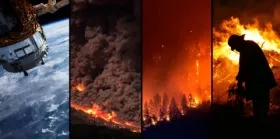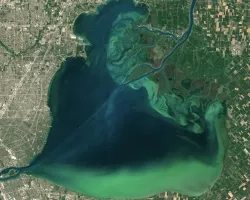Quickly identifying disaster-damaged buildings can be the difference between life and death. Using satellite and aerial images to survey damage is less risky to emergency responders than obtaining ground level views, however reviewing these images is time-consuming because it’s still done using manual methods.
In an attempt to spur innovation in automated damage assessment, NASA Earth Applied Sciences’ Open Innovation program has joined forces with Defense Innovation Unit (a US Department of Defense Research and Engineering organization) to challenge the computer vision community to create automated or semi-automated processes to quickly identify damaged buildings in satellite and aerial images.
The xView2 Challenge, developed by the Defense Innovation Unit and other humanitarian assistance and disaster recovery organizations, includes $150,000 in cash awards to the top solvers who can accurately locate and assess damage to buildings using pre- and post- disaster images.
Solvers analyze images in a set of data provided as part of the competition. That data, called xBD dataset, is one of the largest and highest-quality publicly available collections of annotated high-resolution satellite imagery of damaged buildings.
Challenge participants compete on three possible tracks with each track including different protections of licensing and different awards. Submissions to all tracks are ranked on an active leaderboard based on their top scores.
- Open source. Individuals/Teams compete for leaderboard position with top scores. By releasing their models publicly under a permissive open source license, teams also become eligible for an additional open source award.
- Non-exclusive government purpose rights. Individuals/Teams grant government purpose rights. Solutions can be used to help future disaster recovery efforts.
- Evaluation Only. Individuals/Teams retain intellectual property and other rights to benchmark their solution. Top teams in this category will still be eligible for a special monetary prize pool for their submissions.
Top solvers in all tracks are eligible for follow-on prototyping opportunities.
Equipped with the capability to source and benchmark solutions from around the world, the xView2 Challenge evaluates solutions in real-time to provide immediate technical feedback to the solver community during the competition.
“We are always looking for ways to improve rapid damage assessment to ensure we and our partners deliver the right resources to the right places at the right time, and we are confident the DIU Challenge can contribute to that goal,” said the Federal Emergency Management Agency’s Regional Administrator, Robert Fenton.
The xView2 Challenge is DIU’s second prize competition focused on furthering innovation in computer vision for humanitarian assistance and disaster relief efforts. This year’s competition builds on a previous challenge, which sought out computer vision algorithms to locate and identify distinct objects on the ground useful to first responders.
For xView2, DIU led a team of experts from academia and industry to create a new dataset, called xBD. It allows for localization and damage assessment before and after disasters and is currently the largest and most diverse annotated building damage dataset. The open source electro-optical imagery (0.3 m resolution) xBD dataset encompasses 850,736 building annotations across 45,361 square kilometers of freely available imagery from over 10 countries and includes six disaster types: wildfire, landslides, volcanic eruptions, earthquakes/tsunamis, wind and flooding damage.
Currently, raw satellite imagery is not enough to inform recovery efforts and processing the images into useful information is a slow and laborious process. Seeing specific damage conditions requires high-resolution imagery, but because disasters cover a large ground area, analysts must search through huge swaths of pixel space to localize and score damage. Then that annotated imagery must be summarized and communicated to the recovery team.
The Challenge’s partners represent a first-of-its-kind coalition between the artificial intelligence and disaster response communities including NASA Applied Sciences’ Disasters Program, FEMA’s Region 9, California Governor’s Office of Emergency Services, California Department of Forestry and Fire Protection, the California Guard, the US Defense Department’s Joint Artificial Intelligence Center, the Software Engineering Institute at Carnegie Mellon University, the United States Geological Service, the National Geospatial-Intelligence Agency, and the National Security Innovation Network.
Top algorithms will be integrated into operational workflows for partners at the front lines of humanitarian assistance and disaster relief.
Winners of any cash prize will be considered eligible to be awarded follow-on prototyping work with the Department of Defense in Humanitarian Assistance and Disaster Relief.
The competition started on September 19th, 2019 and will run until December 31st, 2019.
For more information please visit: https://xview2.org/



